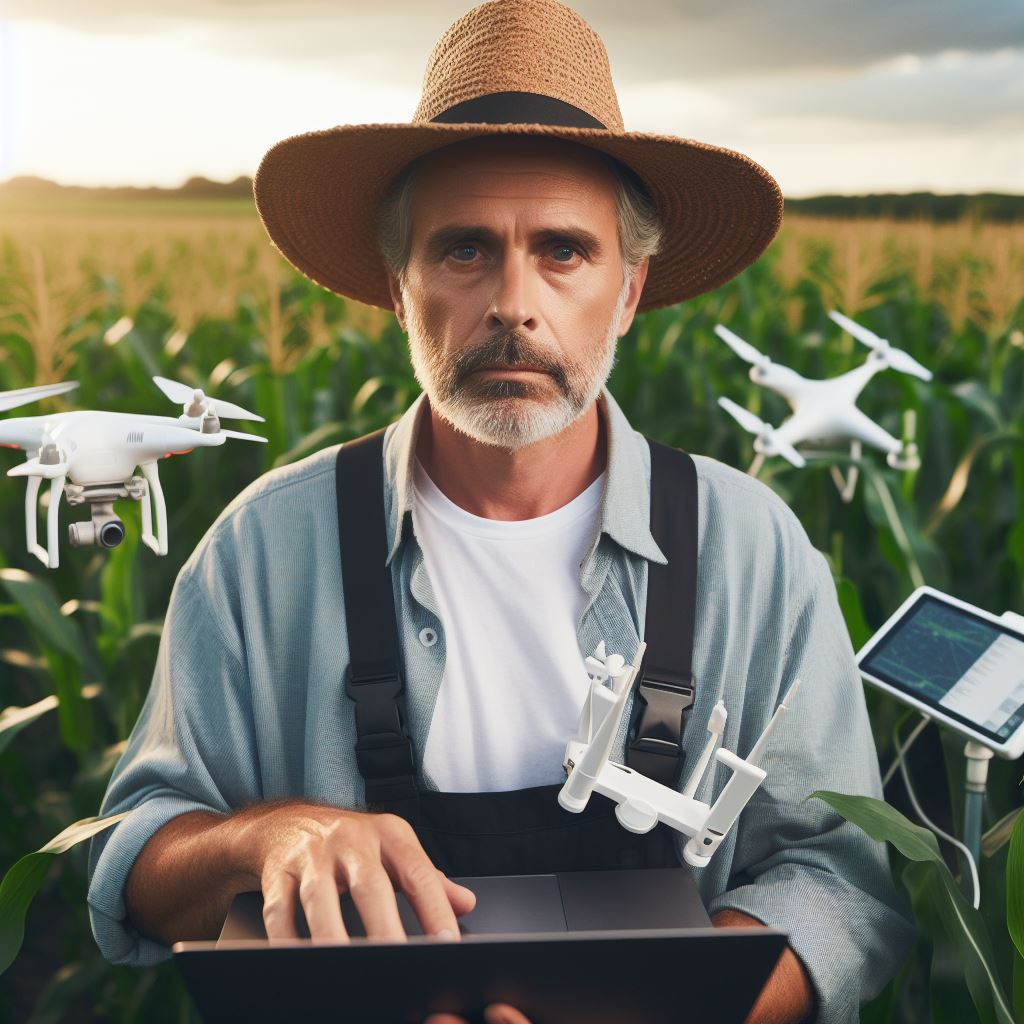Farm Innovations: Alex’s High-Tech Field
Last Updated on March 2, 2024
Introduction
In modern agriculture, farm innovations play a crucial role in the advancement of the industry. One notable example of an innovative farm is Alex’s High-Tech Field.
This blog post aims to showcase the cutting-edge technologies used in Alex’s High-Tech Field.
Keeping up with rapidly evolving agro-industrial technologies is key for farmers and agriculturalists seeking optimal productivity and sustainability.
Alex’s High-Tech Field serves as a shining example of how technology can revolutionize traditional farming practices.
By exploring the advancements employed in Alex’s High-Tech Field, this blog post seeks to inspire and educate readers on the possibilities for modernizing agriculture.
From automation to data analytics, these technologies have the potential to significantly improve farming efficiency and output.
Through the lens of Alex’s High-Tech Field, we will delve into the world of precision agriculture and its impact on crop cultivation, irrigation, and pest control.
The integration of smart sensors, drones, and AI-powered systems employed in this innovative farm will be examined in detail.
Moreover, the post will shed light on the benefits that these technologies offer, such as reduced resource consumption, increased yields, and enhanced sustainability.
By showcasing Alex’s High-Tech Field, we hope to illustrate the transformative power of farm innovations in modern agriculture.
Join us on this enlightening journey as we explore the wonders of Alex’s High-Tech Field and unravel the potential of farm innovations in revolutionizing the future of agriculture.
Stay tuned for an immersive experience into the realm of cutting-edge farming technologies.
Background of Alex’s High-Tech Field
Alex, the Innovative Farmer
Alex is a visionary farmer passionate about leveraging technology to revolutionize agriculture. Growing up in a small farming community, he developed a deep appreciation for the land and its potential.
Location and Size
Situated on the outskirts of a bustling town, Alex’s High-Tech Field spans an impressive 100 acres of fertile soil. Its strategic location allows for easy transportation and access to urban markets.
Unique Characteristics and Challenges
- Weather Variability: Alex faces extreme weather on the farm, demanding innovative approaches for crop survival and optimal yield.
- Advanced Irrigation Systems: Alex maximizes plant health with cutting-edge irrigation, utilizing sensors and weather data for precise water application, minimizing waste.
- Automated Planting and Harvesting: Alex boosts efficiency with robotic technology for planting and harvesting, cutting labor costs and accelerating the farming process.
- Precision Agriculture Practices: Alex adopts precision agriculture with GPS-guided machinery and drones, optimizing resources, reducing waste, and maximizing yield through a data-driven approach.
- Renewable Energy Integration: Alex’s High-Tech Field employs solar panels and wind turbines for clean energy, cutting costs and enhancing environmental friendliness.
- Vertical Farming Structures: Maximizing land use, Alex employs vertical farming structures, utilizing shelves and stacked trays for efficient cultivation and additional growing space.
- Controlled Environment Technology: Using advanced technology, Alex regulates the farm’s climate, optimizing conditions for plant growth, extending growing seasons, and maintaining consistent produce quality.
- Data Analytics and Decision Making: Alex employs big data for informed decisions on seed, fertilization, and pest control, optimizing productivity and minimizing chemical use.
- Collaborative Approach: Alex collaborates with agritech, universities, and fellow farmers, fostering continuous learning to stay at the forefront of agricultural innovation.
- Education and Outreach: Recognizing education’s importance, Alex hosts workshops and farm visits, fostering awareness and interest in sustainable farming practices for the next generation.
In fact, Alex’s High-Tech Field is a remarkable example of how technology and innovation can transform traditional farming.
With an unwavering commitment to sustainability and efficiency, he is shaping the future of agriculture, contributing to food security, and inspiring other farmers to embrace advancements in the field.
Read: The Local Food Hero: Emily’s Story
Innovations in Crop Monitoring
When it comes to crop monitoring, farmers have embraced high-tech solutions to optimize their yields and ensure the health and growth of their crops.
Two of the most powerful tools in this endeavor are drones and satellite imagery.
Drones: Revolutionizing Crop Monitoring
- Drones have transformed the way farmers monitor their crops by providing real-time data and detailed aerial images.
- Equipped with advanced cameras and sensors, these unmanned aerial vehicles revolutionize the field of precision agriculture.
- With drones, farmers can gather valuable information such as crop health, growth patterns, and even detect potential issues before they escalate.
- These aerial platforms fly over the fields, capturing high-resolution images that provide insights that can’t be obtained from ground-level observations.
- Moreover, drones allow for the efficient assessment of large areas of farmland in a fraction of the time that manual inspection would take.”
- This time-saving aspect is crucial for farmers who need to make quick and informed decisions about their crops.
Satellite Imagery: An Eye from the Sky
Satellite imagery has become another game-changer in crop monitoring. With satellites orbiting the Earth, farmers have access to a wide range of data about their crops at a global scale.
These satellites capture images at different wavelengths, enabling farmers to analyze vegetation indices, soil moisture levels, and even detect and track changes over time.
By comparing these images, farmers gain vital insights into the health and growth of their crops.
One of the advantages of satellite imagery is its ability to cover vast areas in a single pass.
This comprehensive view allows for the identification of crop patterns, the assessment of soil conditions, and the detection of potential pest infestations or nutrient deficiencies.
Early Pest Detection and Resource Management
Drones and satellite imagery offer farmers significant advantages in early pest detection. By analyzing the data gathered from these technologies, farmers can identify areas of a field that may be affected by pests or diseases.
Using specialized software, farmers can generate 3D models and thermal maps of their crops, helping them pinpoint regions with abnormal temperature patterns or signs of stress.
This invaluable information allows them to take immediate action and apply targeted treatments to limit the spread of pests and minimize crop damage.
Besides pest control, the data collected by drones and satellites also aids in effective resource management.
By monitoring crop health and growth, farmers can optimize the use of fertilizers, water, and other resources, reducing waste and maximizing their efficiency.
Analyzing Crop Data: Tools for Precision Agriculture
Various software and tools have been developed specifically for analyzing the vast amount of crop data collected by drones and satellites.
- For instance, image processing software can stitch together aerial images, creating orthomosaic maps that provide a detailed and accurate representation of the entire field.
- These maps allow farmers to identify areas that require special attention and plan targeted interventions.
- Other tools use machine learning algorithms to analyze satellite images and provide valuable insights into crop health and growth.
- These algorithms can detect changes in vegetation density, identify specific crop types, and even predict yield estimates.
- Integrating software and tools into precision agriculture enhances farmers’ ability to make data-driven decisions and optimize practices.
In short, the use of drones and satellite imagery in crop monitoring has revolutionized the agricultural industry.
These technologies provide farmers with crucial information about crop health and growth, aid in early pest detection, and enable effective resource management.
With the help of specialized software and tools, farmers can analyze the vast amount of data collected, leading to more efficient and sustainable farming practices.
Read: Farm-to-Fork: Jane’s Organic Practices
Precision Irrigation Techniques
In implementing precision irrigation, soil moisture sensors and weather data are used.
The use of soil moisture sensors and weather data in implementing precision irrigation
Soil moisture sensors are devices that measure the amount of moisture in the soil.
- These sensors provide real-time data, enabling farmers to determine when to irrigate.
- They help prevent both over-irrigation and under-irrigation, optimizing water usage.
- By avoiding excessive irrigation, soil erosion and nutrient leaching are reduced.
- This technology ensures that crops receive adequate moisture for optimal growth and development.
- Weather data is another crucial factor in precision irrigation.
- It includes information on temperature, humidity, wind speed, and solar radiation.
- By analyzing this data, farmers can adjust irrigation schedules and amounts accordingly.
- For example, if rain is forecasted, irrigation can be skipped to avoid water wastage.
- Utilizing both soil moisture sensors and weather data helps achieve precision in irrigation.
Benefits of precision irrigation in conserving water and improving crop yields
The benefits of precision irrigation in conserving water and improving crop yields are significant.
- Water is a scarce resource, and using it efficiently is crucial for sustainable agriculture.
- Precision irrigation ensures that water is applied only when necessary, reducing wastage.
- It helps mitigate water scarcity issues and minimizes the environmental impact of irrigation.
- By providing the right amount of water at the right time, crop yields can be maximized.
- This method prevents overwatering, which can lead to root diseases and lower productivity.
- Additionally, precision irrigation improves nutrient uptake by maintaining optimal soil moisture.
Any other innovative irrigation methods employed in Alex’s High-Tech Field, such as localized irrigation or drip irrigation
Alex’s High-Tech Field utilizes various innovative irrigation methods, including localized irrigation and drip irrigation.
- Localized irrigation focuses water distribution around the root zone of plants.
- This approach minimizes water loss due to evaporation and ensures efficient water utilization.
- Localized irrigation can be achieved through techniques like subsurface drip irrigation and bubblers.
- Subsurface drip irrigation involves placing drip lines below the soil surface, delivering water directly to plant roots.
- Bubblers are devices that release water in a slow and controlled manner directly onto the root zone.
- Drip irrigation, on the other hand, consists of tubes with emitters that deliver water drop by drop to plants.
- This method is highly efficient, reducing water usage while maintaining crop health and productivity.
Overall, precision irrigation techniques, such as soil moisture sensors, weather data analysis, and innovative methods like localized and drip irrigation, play a crucial role in modern farming.
By using these technologies, farmers like Alex can optimize water usage, conserve resources, and increase crop yields.
Read: Meet Your Local Farmer: John Doe’s Story

Automated Harvesting and Planting
Use of robotic or automated machinery for the harvesting and planting process
- Robotic and automated machinery play a crucial role in the harvesting and planting process at Alex’s High-Tech Field.
- This innovative application of technology offers numerous advantages, including increased efficiency, improved accuracy, and significant labor savings.
- Automation has revolutionized farming practices by streamlining the arduous tasks of harvesting and planting.
- Instead of relying solely on manual labor, Alex’s High-Tech Field harnesses the power of advanced machinery to accomplish these essential agricultural activities.
Advantages of automation in terms of efficiency, accuracy, and labor savings
One of the key benefits of automation is the remarkable improvement in efficiency. The use of robotic equipment allows for a faster and more streamlined harvesting and planting process.
These machines can operate continuously, without tiring or requiring breaks, leading to a significant increase in overall productivity.
Moreover, automation ensures a higher level of accuracy compared to traditional methods. Robotic machinery at Alex’s High-Tech Field is equipped with advanced sensors and imaging technologies.
These tools enable precise identification and selection of crops, minimizing errors and maximizing crop yield.
Additionally, automated planting equipment ensures optimal seed placement, leading to improved germination and growth rates.
Labor savings is another significant advantage offered by automated harvesting and planting. These technologies minimize the need for manual labor, reducing costs and reliance on an often scarce workforce.
Alex’s High-Tech Field has succeeded in reallocating labor to more specialized tasks that require human intervention, such as monitoring crop health and quality control.
Any specific automated equipment or technologies utilized by Alex’s High-Tech Field
- At Alex’s High-Tech Field, various automated equipment and technologies are utilized to achieve efficient and accurate harvesting and planting.
- One such equipment is the robotic harvester, equipped with advanced computer vision systems capable of identifying ripe crops and determining the ideal moment for harvesting.
- The robotic harvester can efficiently and gently pick crops without damaging them, ensuring optimal quality and reducing post-harvest losses.
- In terms of planting, Alex’s High-Tech Field relies on automated seeders.
- These machines precisely place individual seeds at the correct depth and spacing, optimizing germination conditions and minimizing the need for thinning.
- The automated seeders also have built-in sensors to detect soil characteristics and adjust planting parameters, accordingly, ensuring optimal growth conditions for each crop.
- Furthermore, integrated robotic control systems manage the entire process at Alex’s High-Tech Field.
- These systems oversee the navigation of the machinery, monitor performance, and make real-time adjustments as necessary.
- They also enable remote monitoring and control, allowing farmers to access critical information and manage operations even from off-site locations.
In essence, automated harvesting and planting have revolutionized the agricultural practices at Alex’s High-Tech Field, offering significant advantages in terms of efficiency, accuracy, and labor savings.
The utilization of robotic machinery, advanced sensors, and intelligent control systems allows for streamlined operations, precise crop management, and increased productivity.
As technology continues to advance, the future of farming holds even greater promise with further automation and innovation.
Learn More: The Rise of Urban Organic Farming
Smart Pest Control Methods
Integration of sensors and advanced algorithms in pest control
Modern agriculture is constantly evolving, and innovative technologies are being developed to address the challenges faced by farmers. One area that has seen significant advancements is pest control.
Traditional pest control methods often relied heavily on chemical pesticides, which come with their own set of drawbacks.
However, with the integration of sensors and advanced algorithms, farmers now have access to smarter pest control methods that are more efficient, environmentally friendly, and cost-effective.
Sensors play a crucial role in smart pest control methods. These tiny devices can be strategically placed across the field to monitor various environmental factors such as temperature, humidity, and light intensity.
By collecting real-time data, sensors provide valuable insights into the conditions that favor pest infestations.
This information is then used in conjunction with advanced algorithms to predict pest populations and determine the most effective control measures.
Use of pheromone traps, automated insect traps, or biocontrol agents
Another innovative approach to pest control is the use of pheromone traps. Pheromones are chemicals released by insects to communicate with each other.
By leveraging this natural behavior, farmers can deploy pheromone traps that lure pests into a sticky or electrified surface, effectively controlling their population. Automated insect traps are also gaining popularity.
These devices use sensors and cameras to detect and capture pests automatically, eliminating the need for manual monitoring.
Biocontrol agents are another vital component of smart pest control. These are beneficial organisms that prey on pests, helping to keep their populations in check.
Ladybugs, for example, are known for their voracious appetite for aphids, a common crop pest.
By selectively introducing these natural predators, farmers can reduce the reliance on chemical pesticides and promote a healthier ecosystem.
Benefits of smart pest control methods in reducing chemical pesticide use and minimizing crop damage
The benefits of smart pest control methods extend beyond reducing chemical pesticide use.
- By precisely targeting pest populations, farmers can minimize crop damage and maximize yields.
- This leads to significant cost savings and increased profitability.
- Additionally, smart pest control methods contribute to sustainable agriculture by reducing the environmental impact associated with traditional pest control practices.
- Furthermore, the use of sensors and advanced algorithms allows for early detection and rapid response to pest outbreaks.
- By identifying and treating infestations at an early stage, farmers can prevent the spread of pests and the potential devastation they can cause.
- This proactive approach to pest management saves time, effort, and resources.
Generally, smart pest control methods revolutionize the way farmers tackle pest infestations.
By integrating sensors and advanced algorithms, utilizing pheromone traps, automated insect traps, and biocontrol agents, farmers can reduce chemical pesticide use, minimize crop damage, and increase overall productivity.
Embracing these technologies is not only economically beneficial but also contributes to a more sustainable and environmentally friendly agricultural system.
Read: Growing Local: Bob’s Community Impact
Conclusion
This section has highlighted various farm innovations, including Alex’s high-tech field. These technologies have proven to have a positive impact on farming efficiency, productivity, and sustainability.
By using advanced tools and techniques, farmers can optimize their operations and maximize yields.
The implementation of precision agriculture, automated irrigation systems, and data-driven decision-making has revolutionized the farming sector.
These innovations enable farmers to monitor crop health, manage resources efficiently, and minimize waste. Such advancements not only enhance productivity but also contribute to sustainable farming practices.
It is essential for readers to explore and support similar farm innovations in their own communities. By embracing these technologies, both small-scale and large-scale farmers can improve their agricultural practices.
Investing in the adoption of these innovations can lead to increased profitability and environmental stewardship.
Furthermore, supporting local farm innovators and organizations is crucial for the continued development of agricultural technologies.
By fostering a collaborative environment, farmers and stakeholders can share knowledge, resources, and experiences to advance the industry further.
In closing, the incorporation of high-tech solutions in agriculture is key to the future of farming. It offers countless benefits such as improved efficiency, increased productivity, and enhanced sustainability.
As we move forward, it is important for individuals and communities to recognize the value of these innovations and actively support their implementation.
Together, we can create a more efficient and sustainable farming industry for future generations.


